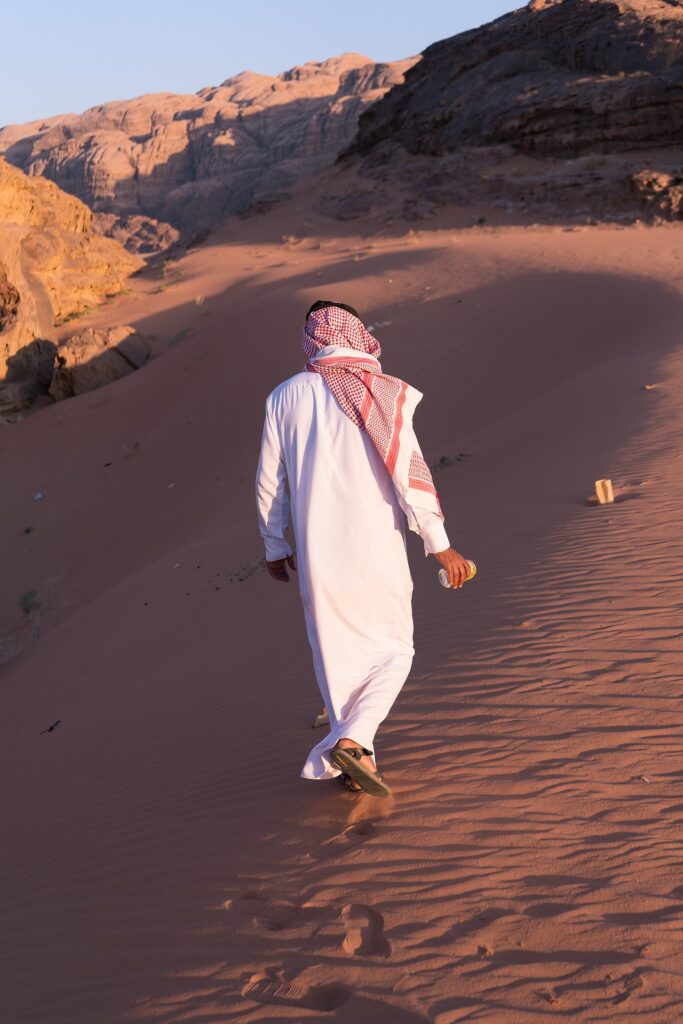Wadi Rum
„Immeasurable, echoing, divine“ This is how Lawrence of Arabia described the impressive desert landscape of Wadi Rum in Jordan. The desert valley of Wadi Rum is Jordan’s largest wadi and is located in the Hisma Desert. Due to its scenic beauty and cultural treasures, Wadi Rum was recognised as a UNESCO World Cultural and Natural Heritage Site in June 2011 as a protected area covering 74,000 hectares. Wadi Rum is located in the southwest of Jordan, east of the city of Aqaba and south of Ma’an, and covers an area of around 6000 square kilometres.
The ochre to red rock formations, the sand dunes and the canyons with their impressive rock paintings are impressive.
The desert and mountains of Wadi Rum are home to many species of flora and fauna, some of are rare and endangered. Endeavor not to disturb them.

Bedouins
Virtually all the people living in and around Wadi Rum are of Bedouin origin and, until recently, led nomadic lives, relying on their goat herds. They belong to seven tribal groups, of which the three largest are the Zalabia tribe who make up the majority of people living in Rum Village (see Rum map); as Rum village is the only village inside the protected area; the Zalabia tribe is largely responsible for tourism services and operate many of the jeep and camel tours. These services are organized through the Rum Tourism Cooperative, a locally run society that shares the tourism business between the villagers.
The other prominent tribal group is the Zweideh tribe, based in the villages of Disi on the northern edge of the protected area. They also run tourism services, including campsites and vehicle tours. Zweideh are not entirely dependent on tourism for their livelihood, having access to a large underground water source that enables them to practice profitable agriculture
Other tribes are Sweilhieen, Omran, Godman and Dbour tribes. They live in different villages depending mainly on livestocks raising and partially on tourism.
Even though most local Bedouin have become villagers, they still maintain goat herds for milk, meat and ‘jameed’, a type of yoghurt. For parts of the year, some families or family members return to a wandering existence with their flocks. Few, however, are able to continue a truly nomadic existence today and the traditional Bedouin lifestyle is fast disappearing.


Nature
Visitors to Wadi Rum usually see very few animals because most desert creatures are nocturnal, to avoid the daytime sun, and many of the larger ones are now reduced to very low numbers. However, if you take the time to look carefully, you are likely to encounter a number of interesting birds, insects and reptiles – and some desert plants – as described below. More detailed information of the wildlife and ecology can be accessed through the library.
Trees are rare in Rum and restricted to three types: Acacias, False Figs and Tamarisks. The Acacias, with their flat tops and spiny, sparse branches, are the most typically desert-looking tree. The plants you will see most often are the short, woody shrubs scattered across the desert, which consist of four main species: White Saxaul, Jointed Anabasis, Hammada salicornica and . These provide an important food source for Bedouin goats and camels, especially in the summer months, when the smaller succulent desert plants have all dried up
The sparse desert scrub harbors a surprising variety of small birds, of which the most common is the buff colored Desert Lark. Other common but more distinctive birds are the black and white Mourning Wheatear and the White Crowned Black Wheatear, whose name gives away its striking color pattern. You are also likely to see African Rock Martins wheeling across the scrub and along the cliffs during the summer months, as well as passing flocks of Tristram’s Grackle, showing their orange wing flashes. In early spring and autumn, Rum becomes an important flyway for birds migrating between Africa and Eastern Europe, especially for birds of prey, like Steppe Buzzards, Honey Buzzards and Steppe Eagles. It is possible to see hundreds of these birds on a single day
Reptiles are widespread in Rum, but do not exist in high numbers. This may be considered fortunate by some visitors, since there are ten species of snake, of which two are very poisonous vipers: Cerastes gasperttii and Echis coloratus. The Cerastes is has the classic ‘side-winder’ movement and leaves indented ‘S’ shaped tracks in the sand. It should be stressed, however, that bites from these snakes (or any snakes) are extremely rare; the vast majority of visitors never see them. The reptiles most likely to be seen are lizards, and especially Geckos and Agamas. The Blue Agama is relatively large, growing up to 35cm and can be seen basking on rocks or hiding in crevices. Males in breeding condition develop an exotic blue head and upper body, which is very conspicuous.
Down on the sand, one common small creature is a black beetle with very long legs called a Blaps beetle. It is frequently seen crossing areas of open sand during the daytime, where it tiptoes to keep its body off the hot ground. Other kinds of invertebrates (insects, spiders and their allies) have different strategies for keeping cool, such as making burrows and hiding under stones. One group of renowned animals that can be found frequently under stones in Rum are scorpions. A total of eight kinds have been recorded so far, from large brown ones to small yellow ones. It is the small, yellow ones that give the most painful sting, although like snakes, few visitors see them and very few ever get stung.
Small, furry mammals are also common in Rum, especially the mouse-like gerbils, with their long back legs, but they are active only at night and few visitors get a chance to see them. Their burrows, however, are easy to spot and they make distinctive tracks across the sand.